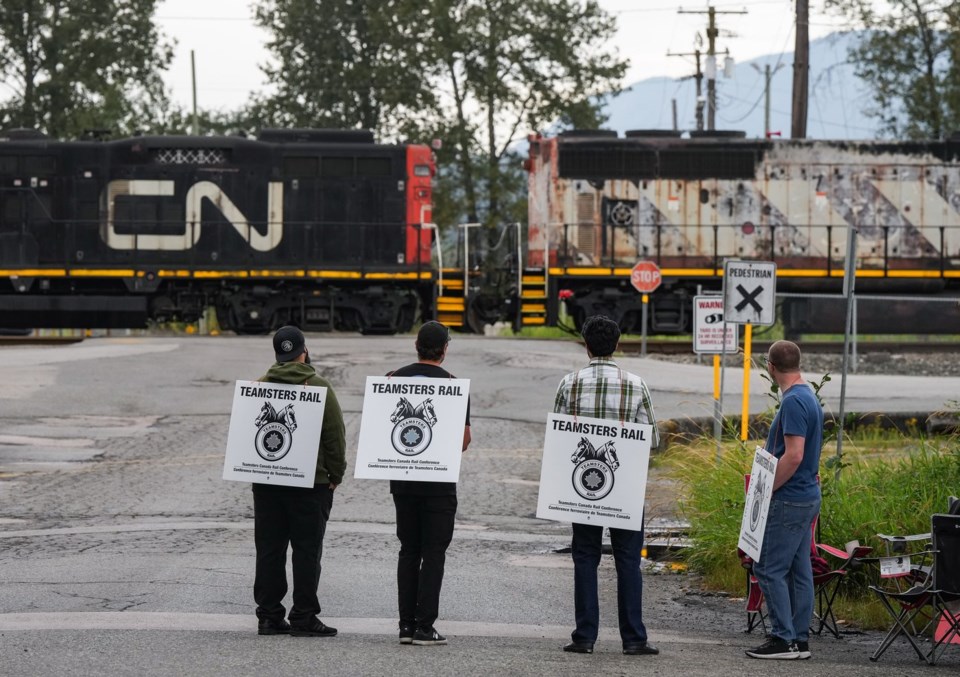MONTREAL — On a sweltering Thursday 51 years ago, a group of striking railroaders stormed Parliament.
For nearly an hour on Aug. 30, 1973, a faction of 200 protesters fought their way into Centre Block, smashing windows and throwing punches, while a much larger group of about 2,500 more railworkers demonstrated peacefully on the front lawn, according to media accounts from Ottawa.
The Montreal Gazette described the melee, saying the group "broke through the main doors in three waves and tried to fight (its) way through police lines to the House of Commons," where the workers were later mandated back to work.
The rampage was at least partly a response to special legislation that would send some 56,000 "non-operations" employees at Canadian National and Canadian Pacific back to work after about 10 days of job action.
That violent scene at Parliament Hill bears little resemblance to the peaceful rallies that dotted Canadian cities over the past week amid a work stoppage at the country's two major railways. But a throughline around wages, working conditions and job stability — as well as economic consequences — runs through stories of rail stoppages over the years.
Simultaneous strikes at CN and CP — now known as Canadian Pacific Kansas City — stopped rail traffic from coast to coast in 1950, 1966, 1973 and 1987.
However, this month's four-day shutdown, which ended Monday morning after a labour tribunal decision ordered the companies and their workers to resume operations, was the first time that the two railways had locked out their employees simultaneously.
News coverage during prior dual strikes noted the consequences for a range of industries, from agriculture and retail to mining and forestry.
"The work stoppage, which is costing the railways an estimated $20 million daily in lost revenue, has caused widespread alarm particularly in Western Canada, where the regional economy is highly dependent on the movement of bulk commodities such as grain, coal and potash," stated a Toronto Star story from Aug. 26, 1987.
Canadian industry sounded near-identical alarm bells ahead of the stoppage this month.
And much as now, rail companies in 1950 found themselves in competition with trucking firms at the same time as workers were demanding big gains after a period of unsatisfactory wage boosts.
"The railways had come out of the Second World War in pretty beat-up shape," said Greg Gormick, who heads On Track Consulting.
"Thanks to rationing, they couldn't replace equipment. There were strict controls," he said, noting that industrial capacity was aimed at churning out war equipment.
Workers largely put demands for improvements to pay and scheduling on pause as part of the broader war effort. But as with the COVID-19 pandemic, the crucial role railworkers play in maintaining an economic lifeline had become evident during the crisis — and they expected due compensation in its aftermath.
"So you saw a rise of strikes immediately after the war concluded, and they wouldn't be charged with СŔ¶ĘÓƵ unpatriotic," said Peter McInnis, a labour historian at St. Francis Xavier University.
Ultimately, the government stepped in to end the shutdown, like it did last week. Back-to-work legislation — at least one of which had wage hikes written in — under Liberal and Conservative governments put the brakes on all four strikes, all of which took place in August.
Angst over technological advances — from diesel engines in the 1940s to more efficient routing and scheduling methods to automation — also drove the labour strife due to concerns about job security.
"A freight train back in 1950 had a crew of at least five," Gormick said. That's been whittled down over the decades, with the current standard СŔ¶ĘÓƵ a two-person crew.
"Now, they're trying to cut down on the number of locomotives, the number of crews," he said, noting the trend toward longer trains, which can trail across more than than four kilometres.
In the decade leading up to the 1987 strike by 60,000 railroaders, CN and CP eliminated 15,800 union jobs, according to a Toronto Star article from that year.
"And the strikes of the ’60s and ’70s often were about the use of technology and automation to take workers off the line," said Charles Smith, a labour scholar at the University of Saskatchewan.
They also came amid a wave of labour activism, set in motion by a wildcat strike by Canadian postal workers in 1965 that ultimately won civil servants the right to collective bargaining.
The job actions of those years played out against a backdrop of generational change, including within union ranks and leadership. The more aggressive stance of some members occasionally boiled over into violence, such as the Parliament Hill fracas.
But physical altercations have been rare in recent years.
Now, transport sector unions have shown a renewed willingness to dig in their heels over the past couple of years, visible in post-pandemic strikes by B.C. dockworkers, WestJet mechanics and pilots and St. Lawrence Seaway employees.
"There's also been a rise of union expectations around militancy," McInnis said.
This report by The Canadian Press was first published Aug. 27, 2024.
Companies in this story: (TSX:CNR, TSX:CP)
Christopher Reynolds, The Canadian Press

